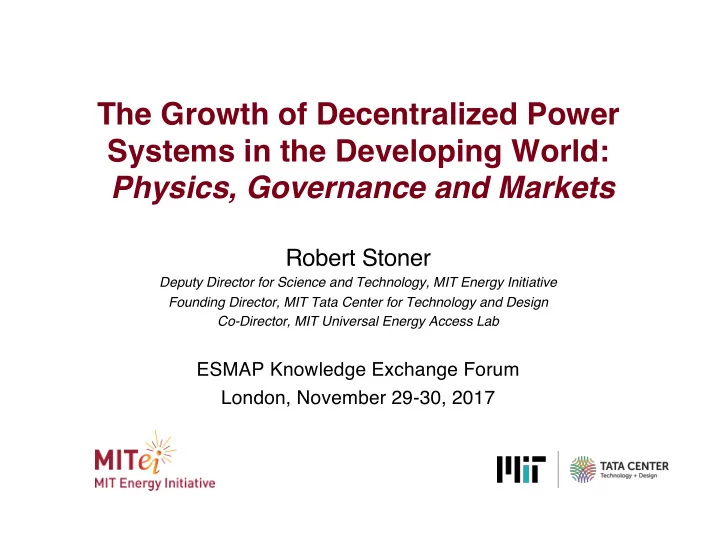

The Growth of Decentralized Power Systems in the Developing World: Physics, Governance and Markets Robert Stoner Deputy Director for Science and Technology, MIT Energy Initiative Founding Director, MIT Tata Center for Technology and Design Co-Director, MIT Universal Energy Access Lab ESMAP Knowledge Exchange Forum London, November 29-30, 2017
The Developing World Advances Toward Universal Access, but sub-Saharan Africa hits a Rural Wall. Having “access” means having the ability to procure a reliable, affordable, sufficient and expandable supply. 1.1B people lacked access in 2016 (IEA) Source: IEA WEO 2017 Special Report – Energy Access Outlook Under IEA’s New Policy Scenario 0.675B lack access by 2030, almost entirely in SSA, now at 43%. 99% of connections in India, and 97% overall since 2000 have been via grid extension.
IEA’s projected new connections 2017-2030 New Policies scenario OFF-GRID Increased solar and increased “mini- (IEA “decentralized”) grids” and “off-grid” systems results from investment consistent with stated government policy. STAND-ALONE Energy for All relative to New Policies scenario Large amount of solar results almost entirely from electrifying remaining remote rural areas in Africa. Source: IEA WEO 2017 Special Report – Energy Access Outlook
The Reference Electrification Model (REM) Identification of customers and 1. associated characteristics Clustering of customers and 2. selection of technology Network and generation design 3.
Kaloleni district (Kilifi County, Kenya) 42,755 unelectrified households in Kaloleni
Sensitivity to grid reliability Grid reliability = 93.75% Grid reliability = 100% Grid reliability = 50%
Sensitivity to diesel price (at 93.75% reliability) Diesel price = $2/liter Diesel price = $1/liter
Recommend
More recommend